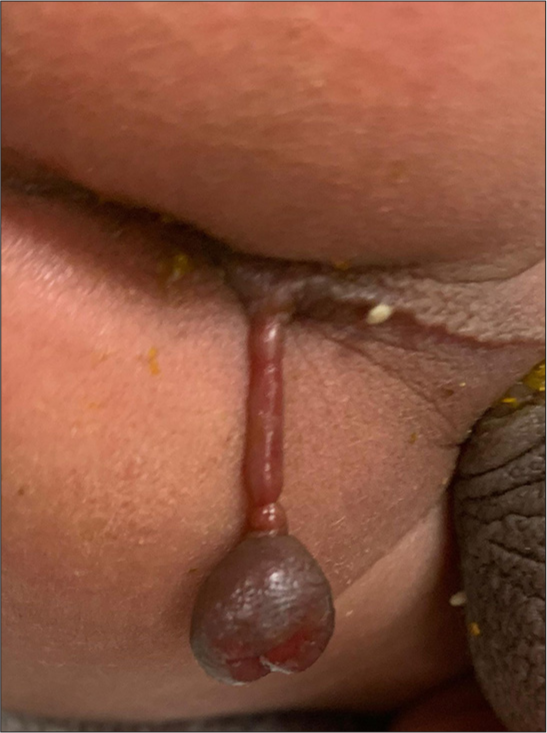Translate this page into:
Anorectal hamartoma: Pedunculated perianal mass in a neonate
*Corresponding author: Thirunavukkarasu Arun Babu, Department of Pediatrics, All India Institute of Medical Sciences (AIIMS), Mangalagiri, Andhra Pradesh, India. babuarun@yahoo.com
-
Received: ,
Accepted: ,
How to cite this article: Tabassum S, Arun Babu T. Anorectal hamartoma: Pedunculated perianal mass in a neonate. Karnataka Paediatr J. doi: 10.25259/KPJ_58_2024
Dear Editor,
A term healthy male neonate, born to a second gravida mother without a history of consanguinity, presented with a pedunculated perianal mass since birth. The neonate had an uneventful postnatal history. There was no discharge or bleeding from the mass, nor were there any signs of infection. In addition, there were no bowel or bladder disturbances.
On local examination, both testes were palpable and descended, with normal male external genitalia. A rounded, non-tender, firm pedunculated mass measuring 1 × 1 cm was noted hanging connected through a pedicle of 1.5 cm attached to the perineal raphe just anterior to the anal opening. The mass had an ulcerated overlying skin [Figure 1]. The anus was normal, with no fissures or prolapse. The mass fell off spontaneously after 1 week, leaving behind an appendage measuring 0.5 cm. Based on the clinical presentation, a provisional diagnosis of hamartoma was diagnosed. As part of the follow-up, magnetic resonance imaging of the spine was done to rule out neural tube defects.

- Pedunculated perianal mass measuring 1× 1 cm.
The differential diagnosis for pedunculated perianal masses in neonates includes conditions such as hamartomas, acrochordons and melanocytic nevi. Pedunculated perianal masses are generally benign. Congenital perianal masses are exceedingly rare and sparsely documented in medical literature. When congenital, these masses are often associated with other anomalies or syndromes.[1]
Common congenital masses such as sacrococcygeal teratomas, giant congenital melanocytic nevi, Langerhans cell histiocytosis, rectal duplication cysts and rhabdomyosarcomas rarely present as isolated lesions.[2,3] Sacrococcygeal teratomas originate from the coccyx and not from the anal canal or anal verge. Rectal duplication cysts are connected to the gastrointestinal tract and typically present with complications such as infection, fistula formation or bowel obstruction during childhood.
In contrast, the mass in this case was asymptomatic, showed no communication with the gastrointestinal tract and did not involve the coccyx or urinary system.
This case highlights the importance of careful evaluation and follow-up of congenital perianal masses to determine their nature and rule out associated anomalies. This report adds valuable insights to the limited existing literature on congenital perianal masses in neonates.
Ethical approval
Institutional Review Board approval is not required.
Declaration of patient consent
The authors certify that they have obtained all appropriate patient consent.
Conflicts of interest
There are no conflicts of interest.
Use of artificial intelligence (AI)-assisted technology for manuscript preparation
The authors confirm that there was no use of artificial intelligence (AI)-assisted technology for assisting in the writing or editing of the manuscript and no images were manipulated using AI.
Financial support and sponsorship: Nil.
References
- Pediatric pedunculated perianal problems. J Pediatr Surg Case Rep. 2016;9:45-8.
- [CrossRef] [Google Scholar]
- Pedunculated perianal mass in a neonate: A rare case report. Am J Dermatopathol. 2020;42:601-3.
- [CrossRef] [PubMed] [Google Scholar]





